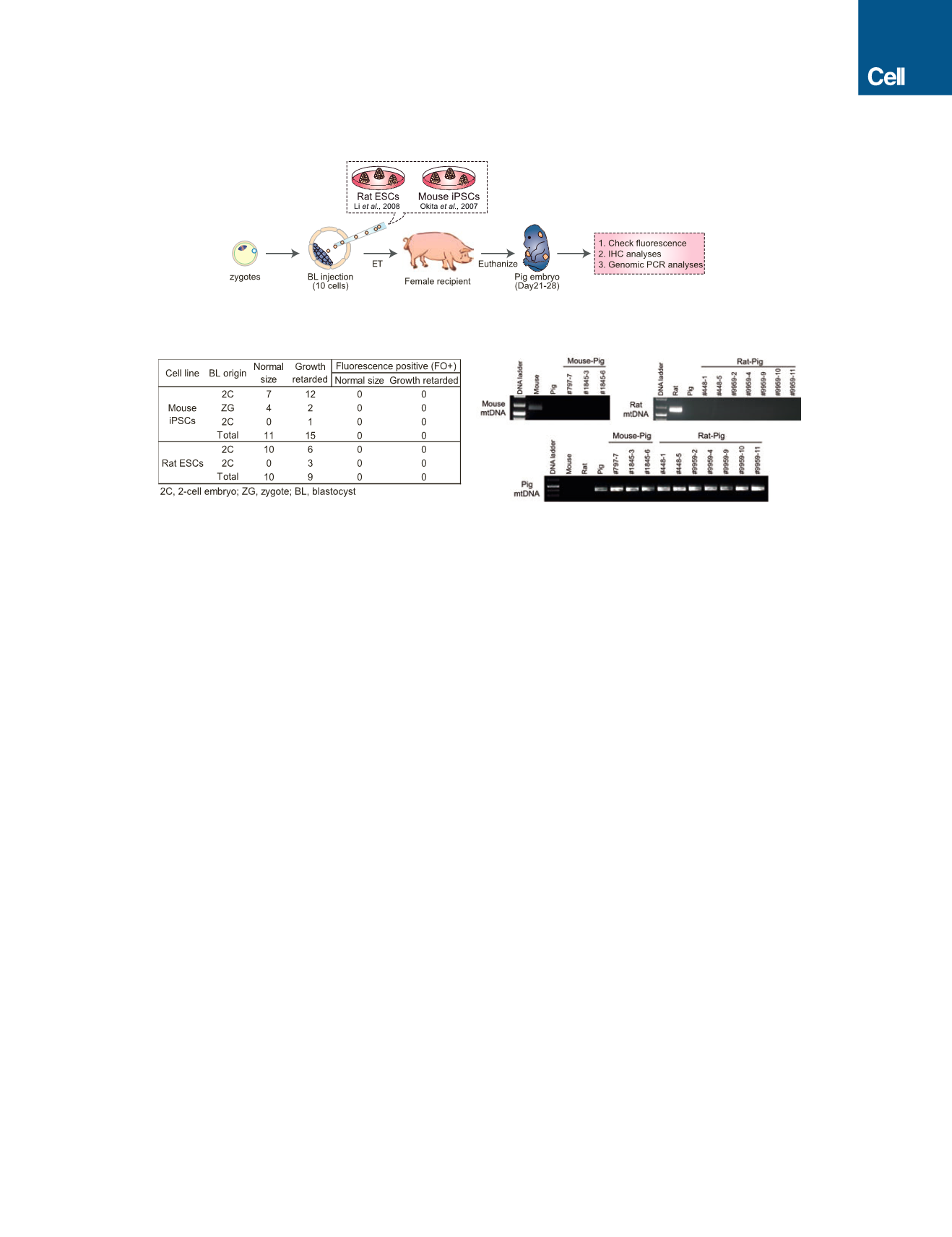

the efficacy and versatility of the CRISPR-Cas9 mediated inter-
species blastocyst complementation platform.
Naive Rodent PSCs Do Not Contribute to Chimera
Formation in Pigs
It is commonly accepted that the key functional feature of naive
PSCs is their ability to generate intraspecies germline chimeras
(Nichols and Smith, 2009). Studies in rodents also support the
notion that attaining the naive pluripotent state is the key step
in enabling chimera formation across species boundaries (Xiang
et al., 2008; Isotani et al., 2011; Kobayashi et al., 2010). However,
it has not yet been tested whether naive rodent PSCs can
contribute to chimera formation when using a non-rodent host.
To further examine the relationship between naive PSCs and
interspecies chimerism, we injected rat ESCs into pig blasto-
cysts followed by ET to recipient sows. In addition to rat ESCs,
we also used a germline competent mouse iPSC line (Okita
et al., 2007). Several criteria were used to determine the chimeric
contribution of rodent cells in pig embryos, namely, (1) detection
of fluorescence (hKO) signal, (2) immunohistochemical (IHC) la-
beling of embryo sections with an anti-hKO antibody, and (3)
genomic PCR with mouse- or rat-specific primers targeting mito-
chondrial DNA (mtDNA) (Figure 3A). We terminated the preg-
nancy between day 21–28 of pig development and collected
embryos derived from the injection of mouse iPSCs or rat
ESCs into pig blastocyst (26 and 19 embryos, respectively) (Fig-
ure 3B; Table S3). We failed to detect any hKO signal in both
normal size and growth retarded embryos (Figure 3B). We next
sectioned the pig embryos and stained them with an antibody
against hKO. Similarly, we did not detect any hKO-positive cells
in the embryonic sections examined (data not shown). Finally, we
employed a more sensitive test, using genomic PCR to amplify
rat- or mouse-specific mtDNA sequences (pig-specific mtDNA
primers served as the loading control) (Table S2). Consistently,
genomic PCR analyses did not detect any rodent contribution
to the pig embryos (Figure 3C). Taken together, although naive
rodent PSCs can robustly contribute to rodent-specific interspe-
cies chimeras, our results show that these cells are incapable of
contributing to normal embryonic development in pigs.
Generation of Naive, Intermediate, and Primed hiPSCs
Next, we sought to systematically evaluate the chimeric compe-
tency of hPSCs in ungulate embryos. We generated hiPSCs
using several reported naive PSC culture methods, a culture
protocol supporting a putative intermediate pluripotent state
between naive mESCs and primed mEpiSCs (Tsukiyama and
Ohinata, 2014), and a primed culture condition (Figure 4A).
Mouse ground state culture condition (2iL) induces the differen-
tiation of primed hPSCs. However, when combined with the
forced expression of NANOG and KLF2 (NK2), transcription fac-
tors that help to maintain murine naive pluripotency, 2iL culture
can stabilize hPSCs in an immature state (Takashima et al.,
2014; Theunissen et al., 2014). We generated doxycycline
(DOX)-inducible NK2-expressing naive hiPSCs cultured in 2iL
medium from primed hiPSCs (2iLD-hiPSCs). Transgene-free
primed hiPSCs were reprogramed from human foreskin fibro-
blasts (HFFs) using episomal vectors (Okita et al., 2011). For
comparison, we also generated naive hiPSCs from HFFs
using the NHSM culture condition (Gafni et al., 2013) (NHSM-
hiPSCs). It has been shown that cells grown in 4i medium, a
A
B
C
Figure 3. Naive Rodent PSCs Fail to Contribute to Chimera Formation in Pigs
(A) Schematic of the generation and analyses of post-implantation pig embryos derived from blastocyst injection of naive rodent PSCs.
(B) Summary of the pig embryos recovered between day 21–28 of pregnancy.
(C) Genomic PCR analyses of pig embryos derived from blastocyst injection of mouse iPSCs or rat ESCs. Mouse- and rat- specific mtDNA primers were used for
the detection of chimeric contribution from mouse iPSCs and rat ESCs, respectively. Pig-specific mtDNA primers were used for the control.
See also Tables S2 and S3.
Cell
168
, 473–486, January 26, 2017
477


















